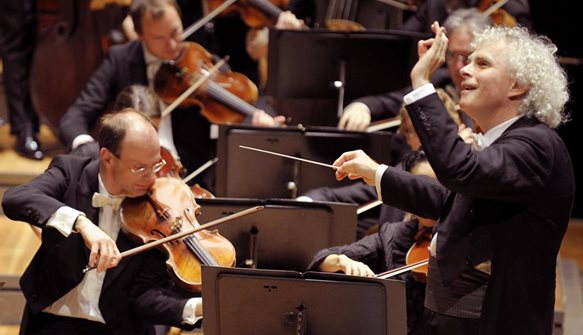
BERLINERS GO VIENNESE IN SAN FRANCISCO
Both sides of the Berlin maestro Simon Rattle were evident and resplendent in the tour concert given on Thanksgiving eve: The formalist/modernist in the Second Vienna School, and the sensual interpreter of Brahms’ Second Symphony—two realms of music many miles apart, though all heavily weighted to Austria. The impact was quite overwhelming, with wild audience huzzahs at each conclusion.
Half the program went over to Schoenberg, Webern and Berg, a thicket of often rebellious, impenetrable music that rewrote almost everything you learned in the Theory of Harmony class. This is music of rebellion. This trio of ground-breakers with works from 1909-1915 reflected the growing instability within the old order of the European political establishment. Schoenberg was the eldest, tearing away from Mahler and R. Strauss, in foment with his shards of sound, and rarely a theme of more than four notes, sometimes with three separate elements fighting for visibility simultaneously, and only glints of tonality. His large orchestra and heavy percussion suggest a restless giant in “Five Pieces for Orchestra.” The most memorable segment is the gentle, genteel “Colors,” where a chord is held, but with different instruments coming and going.
In “Six Pieces for Orchestra,” Webern’s orchestra is both transparent and aphoristic in its articulation. There are the sonic wonders of celesta, bells, tamtam that have you wanting to listen with three ears. The processional pace of the work ends in a rousing finale with brass and drums.
Finally we have the Berg “Three Pieces for Orchestra,” an opus both emotional and intense. I liked the restless and effusive “Reigen” segment () coming in big swells, reaching climaxes, then receding. And it ended with the passionate March. With the instability of those allegedly “devilish” tritone intervals. A century ago, these selections set dozens of people running to the exits; when heard Nov. 23, I saw none of that, just a great ovation at the end.
In an unusual linkage, Rattle tied them all together, as if they were one 14-movement opus 51 minutes in length. Fine. But I’d opt rather for a 30-sec. break after each composition, so that listeners could tell unmistakably what was Berg, what was Schoenberg.
The Berliners have evolved since the heyday of the late Herbert von Karajan. Where, in that era, the musicians resisted mightily allowing a second woman into the orchestra (the super-clarinetist Sabine Meyer), this time I counted 13 women in the ensemble. Male or female, this is one of the truly great orchestras in the world, and their every tour concert is one to treasure.
They finished up with a nuanced, mellow, and sensual reading of Brahms’ Second. Ah, that robust octet of string basses! The velvety horns, the sumptuous celli, the dancing nature of the Allegretto, the immense shaping of dynamics, and the dizzying intoxication of the exciting finale. Rattle shapes this symphony exquisitely, even in little hesitations. The crowd at Davies Hall might still be cheering, and perhaps opening up cracks in walls and ceiling.
For more information, visit the SF Symphony event page.